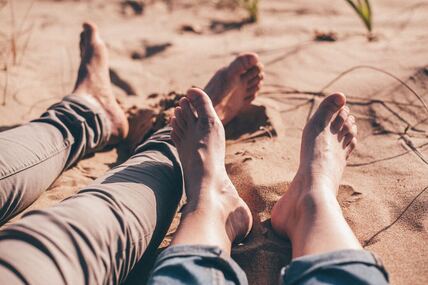We have developed a significant comfort level with telehealth options for our medical and mental health care. My private practice has shifted from providing in-home therapy to meeting with clients solely via encrypted and secure video. Following the pandemic, I found this method highly effective, convenient, safe, and practical for couples and families.

Doing so much by video has changed many things. And one of those things is what we wear while conducting business by video. Since we only see each other from the chest up, this has lent itself to greater freedom in clothing options from the waist down. This may have created some rather embarrassing moments for some, but I can guarantee that I have consistently maintained a must-be-wearing “jeans” policy for all therapy sessions. But I do have a confession. I am barefoot for nearly 100% of therapy sessions. I even have a small heater for my feet in winter because cold toes can significantly distract me.
Walking barefoot has many benefits. So many nerve endings in the bottom of the foot are stimulated when freed from shoes. Before you read any further, go outside and stand in the grass while you finish this blog. Imagine walking on the beach, splashing in the water, and enjoying the sand between your toes. When I walk outside to get the mail, my feet on the grass or pavement causes feelings to move up my entire body. If you are in the grass, notice that now. Those nerve endings activate and cause all manner of emotions. New sensations move from the bottom of our feet through our entire body. Feeling new phenomena in the grass, sand, or concrete often brings unique, heightened awareness. We might be more careful with our steps or slow down and experience the sensations deeply. The effect of the new feelings and heightened awareness is that we are more effectively attuned to our environment.
Another benefit to walking barefoot is loosening constraints. Taking your shoes off after a long day can feel so freeing. There is a bit of tension relief. Having your feet free can even be soothing. There is freedom in being barefoot. Now, I am confident the ladies understand this more than we guys do. You ladies have shoes that press and contort your feet in all manner of uncomfortable ways. We do many things for style and having the right image. We often want to “put the best foot forward” (sorry, I couldn’t help it). But all this foot dressing is also limiting. Something we need freedom from. Being barefoot frees us from the superficial coverings that bind and create discomfort.
I never set out to do therapy in bare feet intentionally. The context of using a home office has made the choice a natural one. And the experience of doing therapy in bare feet has helped connect me with some important values for treatment.
Heightened awareness of self and our other relationships is necessary for change in therapy. We have to learn to slow down and listen more. We tune into our feelings and reactions to understand their source better. Just as walking barefoot helps us feel new feelings and possibly feel them more deeply, participating in therapy can do the same. Feeling deep and connecting with our inside selves is a part of the therapeutic process. We call this process insight or gaining self-awareness. It requires us to observe, reflect, and draw inferences about our experiences, feelings, and emotions. When working with a couple, individual, or family, I find success in peeling past immediate problem-solving solutions and helping make insightful connections to our inner experiences and feelings. This process is not always comfortable, and it can even be painful. It is like stepping on an unexpected sharp stone when walking through the yard (or a Lego in a dark house). But it is often in these new spaces of awareness we can see, understand, and experience our problems in a way that can facilitate change.
Just like removing our shoes loosens constraints, we must do similar things in therapy. We must push our boundaries, nudge outside our comfort zones, and challenge our conventional thinking. When we experience problems in life, they are often supported by assumptions, beliefs, and values that can bind us. We may feel compelled to live behind a mask or project a particular identity. Change is at the center of therapy. Change means many things, including seeing, thinking, feeling, and behaving differently. To experience change, we have to get unstuck; successful therapy helps us to do that. Hopefully, working together in therapy creates a type of freedom. In this space, we can test, challenge, and change those constraints in our lives that have us trapped or stuck.
Therapy in bare feet is a good idea. I encourage you to do the same. Take your shoes off and walk in the grass. Feel new things. Feel them more deeply. Find the freedom to explore new feelings, test your assumptions, and challenge yourself to growth and change. Show your therapist your bare feet on the screen or take your shoes off in their office. Tell them you want to do therapy in your bare feet. I don’t think they will mind.
Leave a Reply